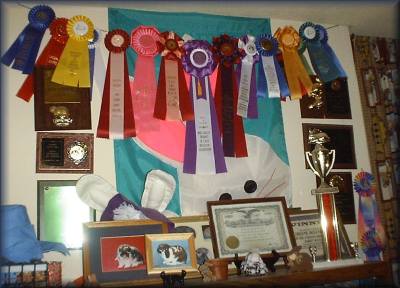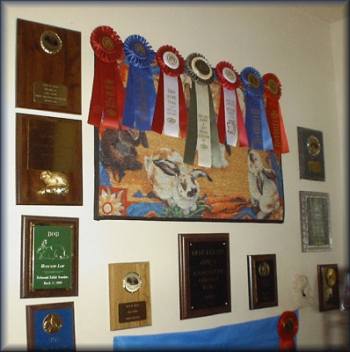![]()

I remember the anxiety I felt, prior to my first rabbit show. I had no one to ask about what to take, or how to fill out my entry form, or even how to get a catalog. I will outline some of the things I've learned, in hopes that it will help someone else in that situation.
The first thing you need to do, if you intend to start attending shows, is to look through the listing of sanctioned shows in the ARBA Domestic Rabbit. This section lists the club name, location of the show, and the secretary's name and mailing address. The only way to acquire a show catalog, is to write and politely request one. After you have entered one year, you should get one in the mail the next year. Now the operative word here is should, because in some states this isn't common practice. One such state is New York. They expect you to pick them up at other area shows, and sometimes you'll get one in the mail the following year.
The next step will be checking to see if the show is a "closed entry" show or a "day of show entry" show. Closed entry shows, require your entry sheet and entry fees be sent in normally a week in advance of the show date. A day of show entry, allows you to wait until you arrive to fill out your entry, comment cards, and usually gets a late start because of all this. It is, however, nice, because you can decide who to take the day before, instead of a week before. This will avoid having to substitute rabbits if something happens that the entries can't go.
Your next step will be to decide who you want to take, and fill out your entry form. On the entry form they will ask for breed and variety. This means the breed of rabbit and the color. There are different classifications of colors that different breeds are shown in. In the case of the lop breeds, they're shown in either broken or solid. In others, they are shown by category like Agouti, Shaded, Self , All Other Varieties, and Tan Patterns. Each breed is unique in the groups they're shown in. This is what is referred to on the entry as variety. The next area is the rabbit's ear number. Then you'll need to put down the age group of your rabbit, for Class and it's gender for Sex. Next you'll list the entry fee. They range between $2 and $3 as a rule. Add up your fees and make your check out to the club, and mail it and the entry form to the secretary by the date they list as the post mark cut off date. Make SURE you make a copy of the entry before sending it, or make a separate copy of your own, so that you know who you have entered when it's time to load them for the show. You will want to make sure your rabbits are cleaned up and ready to go before the show day.
It is important that you read and understand the directions before the show day. This may entail looking at a map and comparing it to the directions listed in the catalog, or running a directions program on the computer. Whatever it takes, make sure you know how to get there, and have an idea of the driving time. This is important in order to arrive on time.
It is my recommendation to be to the shows by 7:30 and no later than 8:00, because most show rooms are not big enough to accommodate everyone, so if you want your rabbits comfortable, be there early enough to get them in there and settled without rushing.
When you arrive, drive to the entrance that appears to be where everyone is unloading. Unload your rabbits there, and then move your vehicle to the proper parking area. Don't piddle too long, blocking the unloading area. As you're unloading, look for the table where you'll be judged. If they don't have it designated yet, by listing your breed, you'll just have to put everything somewhere to wait until they get the signs up. In the meantime, you can go to the secretary's table, usually centrally located, and check in. This may entail getting a list of the coop numbers for your rabbits' ears, or getting your comment cards, or just checking that they have your entry. This varies from club to club. At some shows you have to take your cards, and bring them with each rabbit to the table. At some, they are already in the folder they take to the table.
At this time, you should find out where and when your breed will be judged, if you haven't already. Put your rabbits and belongings, near that area and wait for your breed to be called. The rabbits in the breeds are judged in the same order each time. In the case of the Hollands...they are judged by first: Solid Senior Bucks, then Solid Senior Does, then Solid Junior Bucks, then Solid Junior Does. They start with the older bucks and then the does in the solids and do the same in the broken variety. This will be the same at each show, so it is easier to keep track of when your classes are. It is always best to stay at the table once the judging begins, so you learn about your breed and know when your rabbits need to be taken up.
When you have a rabbit entered in a class, you take it, and it's card if they gave them to you, up to the table. Give the card to the writer, and put the rabbit in the box or where ever they are placing them. The judge will check all the rabbits' gender and for disqualifications first, and then start placing them. Listen carefully when they're giving comments, so you will learn the terminology and will hear your rabbit's ear number when the judge gets to him/her. You should not designate your rabbit as yours to anyone at the table, until you go to pick it up when the judge is finished with it's comments. The judge isn't supposed to know what rabbit belongs to whom.
When a rabbit wins a class, it is kept up behind the judging table, to compete further, in best of variety and if it wins there, for best of breed or best opposite sex of breed. If it wins Best of Breed, it is eligible to compete for Best Four Class and then on to Best In Show if it wins there.
On a separate page, I have an article regarding what to take to shows. This is also helpful for a first timer before a show.
One thing that is good to remember. If your rabbit does badly, it is not necessarily a terrible rabbit. It is one judge's opinion, and they are human, and may be having a bad day, or may not have a good grasp on the breed's particular standard. We have to deal with this when we show. It's part of the hobby. You just have to look at the overall picture for each animal. How do they do under a number of judges. It's very common to not find two judges that will like the same animal, so they can't all be adhering to the standard while judging, so don't take one opinion too seriously.
Try to have a good time. This hobby can be very rewarding, competitive and exciting, and the friends you make at shows can be wonderful. Good luck showing.
![]()



![]()
